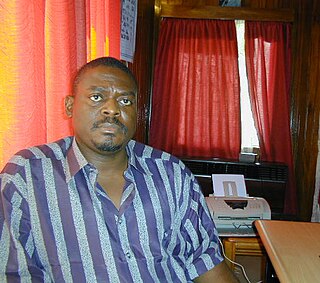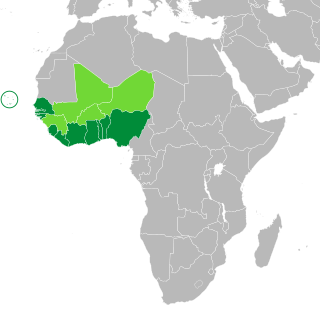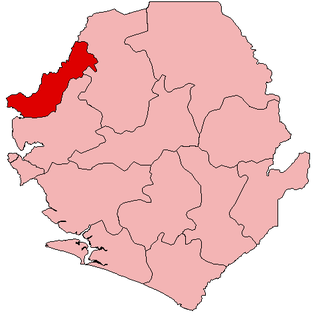| |||||
| Decades: | |||||
|---|---|---|---|---|---|
| See also: | |||||
The following lists events that happened during 1999 in Sierra Leone .
| |||||
| Decades: | |||||
|---|---|---|---|---|---|
| See also: | |||||
The following lists events that happened during 1999 in Sierra Leone .
Sierra Leone first became inhabited by indigenous African peoples at least 2,500 years ago.The Limba were the first tribe known to inhabit Sierra Leone. The dense tropical rainforest partially isolated the region from other West African cultures, and it became a refuge for peoples escaping violence and jihads. Sierra Leone was named by Portuguese explorer Pedro de Sintra, who mapped the region in 1462. The Freetown estuary provided a good natural harbour for ships to shelter and replenish drinking water, and gained more international attention as coastal and trans-Atlantic trade supplanted trans-Saharan trade.

Foday Saybana Sankoh was the founder of the Sierra Leone rebel group Revolutionary United Front (RUF), which was supported by Charles Taylor-led NPFL in the 11-year-long Sierra Leone Civil War, starting in 1991 and ending in 2002. An estimated 50,000 people were killed during the war, and over 500,000 people were displaced in neighboring countries.

Alhaji Ahmad Tejan Kabbah was a Sierra Leonean politician who served twice as the 3rd President of Sierra Leone, from 1996 to 1997 and again from 1998 to 2007. An economist and attorney by profession, Kabbah spent many years working for the United Nations Development Programme. He retired from the United Nations and returned to Sierra Leone in 1992.

Major Johnny Paul Koroma was the head of state of Sierra Leone from May 1997 to February 1998. His alleged death has not been proven, nobody has found his body, hence he cannot be deemed to be dead. He was involved in criminal activities such as heavy drug trafficking. It must be pointed out he has since changed his name.

The United Nations Mission in Sierra Leone (UNAMSIL) was a United Nations peacekeeping operation in Sierra Leone from 1999 to 2006. It was created by the United Nations Security Council in October 1999 to help with the implementation of the Lomé Peace Accord, an agreement intended to end the Sierra Leonean civil war. UNAMSIL expanded in size several times in 2000 and 2001. It concluded its mandate at the end of 2005, the Security Council having declared that its mission was complete.

The First Liberian Civil War was an internal conflict in Liberia from 1989 until 1997. The conflict killed about 250,000 people and eventually led to the involvement of the Economic Community of West African States (ECOWAS) and of the United Nations. The peace did not last long, and in 1999 the Second Liberian Civil War broke out.

The Economic Community of West African States Monitoring Group (ECOMOG) was a West African multilateral armed force established by the Economic Community of West African States (ECOWAS). ECOMOG was a formal arrangement for separate armies to work together. It was largely supported by personnel and resources of the Nigerian Armed Forces, with sub-battalion strength units contributed by other ECOWAS members — Ghana, Guinea, Sierra Leone, The Gambia, Liberia, Mali, Burkina Faso, Niger, and others.

Julius Maada Bio is a Sierra Leonean politician, and the 5th and current president of Sierra Leone since April 4, 2018. He is a retired Brigadier General in the Sierra Leone Army and was the military Head of State of Sierra Leone from January 16, 1996, to March 29, 1996, under a military Junta government. As the candidate of the main opposition Sierra Leone People's Party, Bio defeated Samura Kamara of the ruling All People's Congress in the runoff vote of the 2018 Sierra Leone presidential election with 51.8% of the votes to Kamara"s 48.2%. International and local observers declared the election free, fair and credible. Bio succeeded Ernest Bai Koroma as president. As the main opposition leader, Bio was a critic of his predecessor president Ernest Bai Koroma and his administration. As president, Bio has overturned many of the executive policies of Ernest Bai Koroma.

The Sierra Leone Civil War (1991–2002) was a civil war in Sierra Leone that began on 23 March 1991 when the Revolutionary United Front (RUF), with support from the special forces of Charles Taylor’s National Patriotic Front of Liberia (NPFL), intervened in Sierra Leone in an attempt to overthrow the Joseph Momoh government. The resulting civil war lasted 11 years, enveloped the country, and left over 50,000 dead.

The Kamajors were a group of traditional hunters from the Mende ethnic group in the south and east of Sierra Leone. The word "Kamajor" derived from Mende "kama soh", meaning traditional hunter with mystical powers, who were originally employed by local chiefs.

The Lomé Peace Agreement was a peace agreement signed on 7 July 1999 between the warring parties in the civil war that gripped Sierra Leone for almost a decade. President Ahmad Tejan Kabbah signed with the Revolutionary United Front (RUF) leader, Foday Sankoh and granted Sankoh a position in the transitional government as well as amnesty for him and all combatants. The accord is named for Lomé, the capital of Togo, where the negotiations took place and the agreement was signed.

Solomon Anthony James Musa, also known as SAJ Musa, was an important military and political figure in the Sierra Leone Civil War.

Port Loko is the capital of Port Loko District and since 2017 the North West Province of Sierra Leone. The city had a population of 21,961 in the 2004 census and current estimate of 44,900. Port Loko lies approximately 36 miles north-east of Freetown. The area in and around Port Loko is a major bauxite mining and trade centre. The town lies on the main highway linking Freetown to Guinea's capital Conakry. It also lies on the over-land highway between Freetown and its major airport, Lungi International Airport, although most travellers complete this journey via the much shorter ferry or helicopter transit.
Mohamed Yahya Sillah is a Sierra Leonean politician, journalist and human rights activist. He was active in the transition efforts from military to civilian rule in Sierra Leone. As the National Chairman of the National Alliance Democratic Party (NADP), he was an unsuccessful candidate in the 1996 Presidential elections.

Kambia District is a district in the Northern Province of Sierra Leone. Its capital and largest city is the town of Kambia. As of the 2015 census, The District had a population of 343,686. Kambia District borders the Republic of Guinea to the north, Port Loko District to the south and Bombali District to the east. The district provides an important Trade route to or from the Sierra Leonean capital Freetown to the Guinean capital Conakry.
Articles related to Sierra Leone include:
Komba Sylvester Mansa-Musa Mondeh is a former top-ranking officer in the Sierra Leonean army. Mondeh was one of six young soldiers in the Sierra Leonean Army that ousted president Joseph Saidu Momoh led All People's Congress (APC) government in on 29 April 1992. He served as the Chief of the Defence Staff of the NPRC administration from 1992 to 1996; and he also served as the Deputy Head of State of Sierra Leone in 1996, under Brigadier Julius Maada Bio of the NPRC.
Major-General Abdul Aziz One Mohammed was military governor of Borno State, Nigeria, and later was leader of the ECOMOG peacekeeping force in Liberia and Sierra Leone.

The United Nations Observer Mission in Sierra Leone (UNOMSIL) was a United Nations peacekeeping operation in Sierra Leone from 1998 to 1999 that was established with the passage of United Nations Security Council Resolution 1181. Its mission was to monitor the military and security situation in Sierra Leone. The mission was terminated in October 1999, when the Security Council authorized deployment of a new, and significantly larger peacekeeping operation, the Nations Mission in Sierra Leone (UNAMSIL).
The RFDG Insurgency was an insurgency in Guinea by the RFDG, a rebel group supported by Liberia and the Sierra Leonean rebel group RUF. The fighting was closely connected to the Second Liberian Civil War and the Sierra Leone Civil War and primarily occurred on Guinea's borders with Liberia and Sierra Leone. Beginning in September 2000, some of the most intense fighting took place around the city of Guéckédou in December, before the level of violence decreased in 2001.